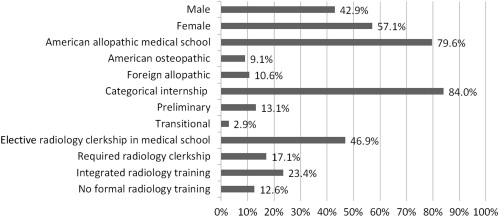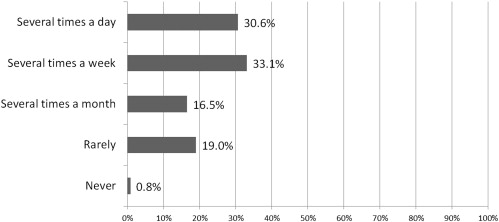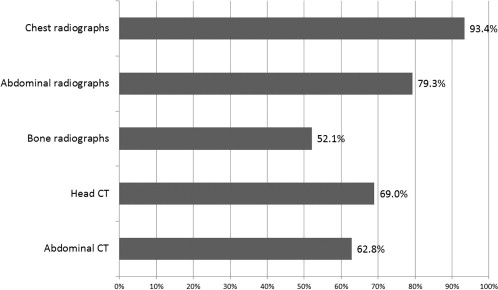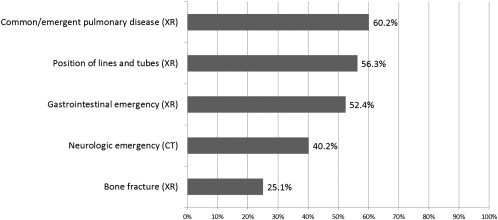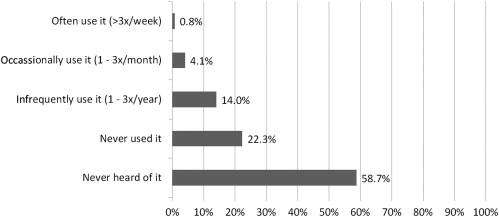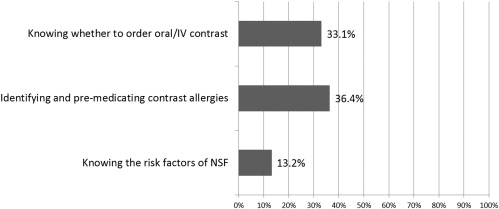Rationale and Objectives
Postgraduate year (PGY)-1 residents are frequently required to order imaging studies and make preliminary interpretations on them. This study determines whether PGY-1 residents feel their radiology education in medical school sufficiently trained them for the clinical responsibilities of internship.
Materials and Methods
This multicenter, institutional review board–approved survey asked PGY-1 trainees three categories of questions: 1) extent of medical school training for ordering and interpreting imaging studies, 2) confidence levels in ordering appropriate imaging studies and making common/emergent diagnoses, and 3) rating the importance of radiologic interpretation by interns. Respondents also submitted ideas for medical school teaching topics deemed most useful for interns.
Results
A total of 175 questionnaires were returned with good representation across specialties. Although 63.7% of interns were frequently asked to independently preview radiology studies, 12.6% received no formal radiology training in medical school. Participants rated chest radiographs as the most important study for interns to competently interpret (93.4% reporting very or extremely important). However, only 60.2% of interns reported high confidence in recognizing common/emergent pulmonary findings, and 56.3% for evaluating line and tube position. With regard to ordering imaging studies, 81.0% had never used or never heard of the American College of Radiology Appropriateness Criteria®. Only 33.1% had high confidence in knowing when to order oral/intravenous contrast. Similar low percentages had high confidence identifying and premedicating contrast allergies (36.4%) and knowing risk factors of nephrogenic systemic fibrosis (13.2%).
Conclusions
PGY-1 residents feel that medical school curriculum emphasizing interpretation of chest radiographs and ordering appropriate imaging studies would better prepare students for the responsibilities of internship.
In the handbook Essentials for Medical Students and PGY-1 Residents , the American College of Surgeons identifies the ability to “order and interpret appropriate laboratory and imaging studies” as integral to the training of postgraduate year (PGY)-1 residents . The interpretive skill set expected of interns includes the recognition of common imaging abnormalities such as pneumonia, small bowel obstruction, pneumoperitoneum, and intracranial hematoma, among many others. These expectations are not unique to surgery, but reflect the general consensus that trainees on the front lines of patient care need basic imaging skills in order to provide appropriate and timely patient care. The purpose of this study is to evaluate the perceived preparedness of interns for these clinical responsibilities based on radiology training received in medical school.
Materials and methods
A 12-question survey was created using SurveyMonkey ( http://www.surveymonkey.com ), an online survey and questionnaire tool. Invitations to participate in the survey were emailed to 95 program directors from across the country representing all specialties offering PGY-1 training. The specialties included internal medicine, obstetrics and gynecology, emergency medicine, general surgery, pediatrics, family medicine, psychiatry, transitional year (not going into radiology), and transitional year (going into radiology). Program directors were asked to forward the invitations to their interns, all of whom had at least 6 months of training. The survey begins by asking interns about their medical school training for ordering and interpreting various imaging studies. The effectiveness of this training was determined by then querying participants about their confidence levels in ordering appropriate imaging studies and making common/emergent diagnoses. Based on their experience, residents were also asked to rate how important it is for interns to competently interpret various imaging studies. Finally, participants were asked to submit ideas for teaching topics deemed most useful for rising interns. The list of questions and answer options from the survey is illustrated in Table 1 . A chi-square test was used to compare questionnaire responses according to specialty. A P value less than .05 was considered to indicate a significant difference. The study was approved by our institutional review board.
Table 1
Electronic Survey Questions Posed to PGY-1 Residents
Question Answer Option
Male; female
American/foreign and allopathic/osteopathic
Categorical; preliminary; transitional
Open-ended
Required clerkship; elective; integrated
Get Radiology Tree app to read full this article<
Not confident; somewhat confident; moderately confident; very confident; extremely confident
Get Radiology Tree app to read full this article<
Not confident; somewhat confident; moderately confident; very confident; extremely confident
Get Radiology Tree app to read full this article<
Not confident; somewhat confident; moderately confident; very confident; extremely confident
3x/week; 1–3x/month; 1–3/year; never use it; never heard of it
Several times a day, week, month; rarely; never
Get Radiology Tree app to read full this article<
Not important; somewhat important; moderately important; very important; extremely important
Open-ended
CT, computed tomography; IV, intravenous; MRI, magnetic resonance imaging; PGY, postgraduate year.
Get Radiology Tree app to read full this article<
Results
Get Radiology Tree app to read full this article<
Get Radiology Tree app to read full this article<
Get Radiology Tree app to read full this article<
Get Radiology Tree app to read full this article<
Get Radiology Tree app to read full this article<
Get Radiology Tree app to read full this article<
Get Radiology Tree app to read full this article<
Get Radiology Tree app to read full this article<
Get Radiology Tree app to read full this article<
Discussion
Get Radiology Tree app to read full this article<
Get Radiology Tree app to read full this article<
Get Radiology Tree app to read full this article<
Get Radiology Tree app to read full this article<
Get Radiology Tree app to read full this article<
Get Radiology Tree app to read full this article<
Get Radiology Tree app to read full this article<
Get Radiology Tree app to read full this article<
Get Radiology Tree app to read full this article<
Get Radiology Tree app to read full this article<
Get Radiology Tree app to read full this article<
Get Radiology Tree app to read full this article<
References
1. 2005.Division of Education, American College of SurgeonsChicago, IL
2. 2011.National Resident Matching ProgramWashington, DC
3. Hirschl D.A., Ruzal-Shapiro C., Taragin B.H.: Online survey of radiologic ordering practices by pediatric trainees. J Am Coll Radiol 2010; 7: pp. 360-363.
4. Bautista A.B., Burgos A., Nickel B.J., et. al.: Do clinicians use the American College of Radiology Appropriateness Criteria in the management of their patients?. AJR Am J Roentgenol 2009; 192: pp. 1581-1585.
5. Chiunda A.B., Mohammed T.L.: Knowledge of ACR thoracic imaging Appropriateness Criteria® among trainees: one institution’s experience. Acad Radiol 2012; 19: pp. 635-639. Epub 2012 Feb 18
6. Logie C.I., Smith S.E., Nagy P.: Evaluation of resident familiarity and utilization of the ACR musculoskeletal study appropriateness criteria in the context of medical decision support. Acad Radiol 2010; 17: pp. 251-254. Epub 2009 Dec 4
7. Feigin D.S., Magid D., Smirniotopoulos J.G., et. al.: Learning and retaining normal radiographic chest anatomy: does preclinical exposure improve student performance?. Acad Radiol 2007; 14: pp. 1137-1142.
8. Subramaniam R.M., Beckley V., Chan M., et. al.: Curriculum topics for medical students: students’ perspectives. Acad Radiol 2006; 13: pp. 880-884.
9. AMSER National Medical Student Curriculum in Radiology. Available at http://www.aur.org/Affiliated_Societies/AMSER/amser_curriculum.cfm . Accessed September 25, 2011.
10. Magid D., Hudson D.W., Feigin D.S.: Chest radiographic anatomy retention: the impact of preclinical groundwork on clinical recall in two schools. Acad Radiol 2009; 16: pp. 1443-1447.
11. Branstetter B.F., Faix L.E., Humphrey A.L., et. al.: Preclinical medical student training in radiology: the effect of early exposure. AJR Am J Roentgenol 2007; 188: pp. W9-W14.
12. O’Malley L., Athreya S.: Awareness and level of knowledge of interventional radiology among medical students at a Canadian Institution. Acad Radiol 2012; 19: pp. 894-901. Epub 2012 Apr 21
13. Naeger D.M., Phelps A., Kohi M., et. al.: Cross-specialty integrated resident conferences: an educational approach to bridging the gap. Acad Radiol 2012; 19: pp. 1029-1034. Epub 2012 May 10
